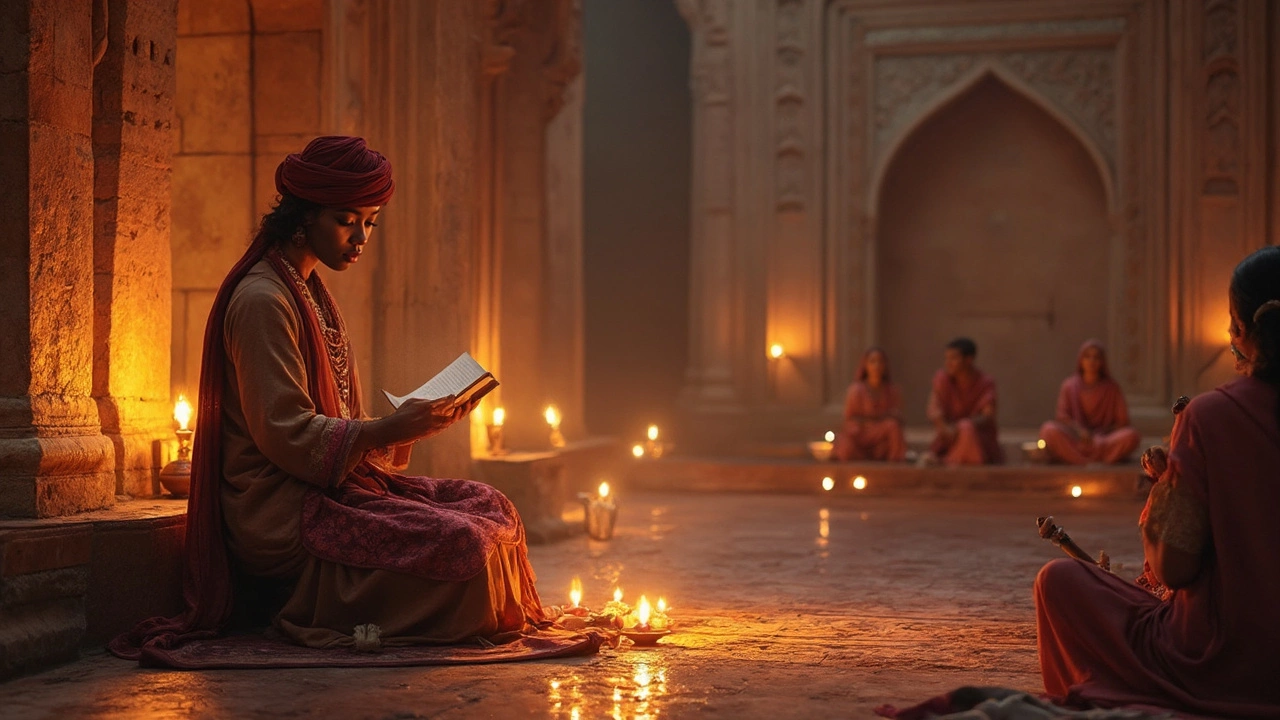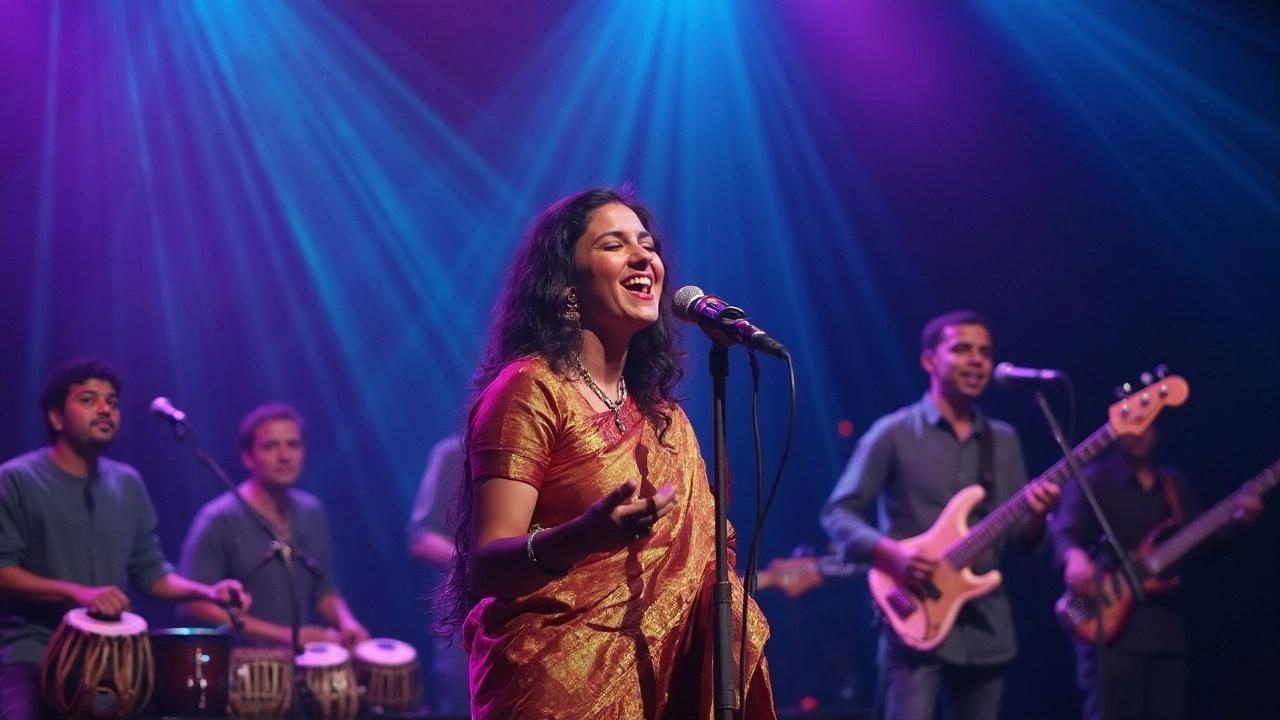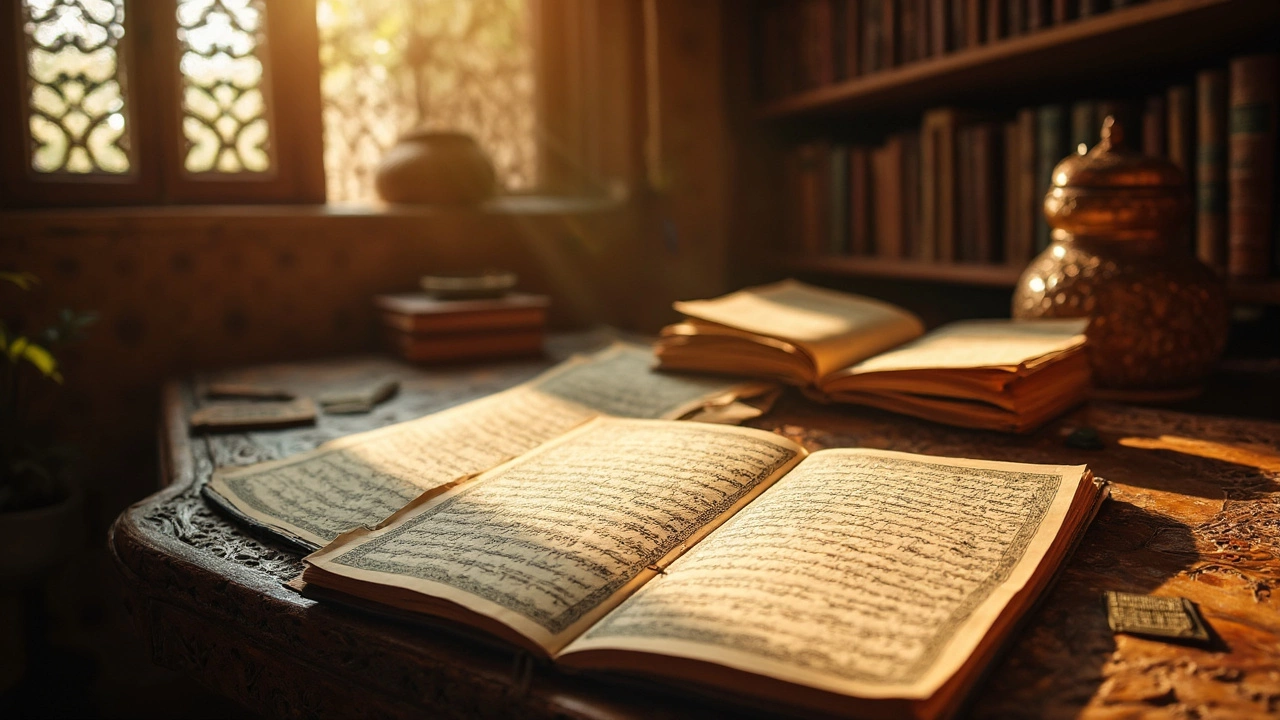Understanding the Essence of Ghazal in India
 Mar, 19 2025
Mar, 19 2025
So, what exactly is a Ghazal? If you've ever enjoyed the emotional depth of poetry, you might have stumbled upon this beautiful form without even knowing it. Originating centuries ago, Ghazals are a form of poetic expression, blending both longing and love in just a few delicate lines. Think of them as short, passionate bursts of emotion that capture the intricacies of human feelings like no other.
The roots of Ghazal poetry trace back to ancient Persia before making its way to the Indian subcontinent, where it gained a unique and cherished place in our literary tradition. Ghazals aren’t just poems. They’re an experience—a journey through one's soul, marked with lyrical beauty and emotional resonance.
One of the cool things about Ghazals is their structured style. They usually consist of rhyming couplets, each one standing alone yet linked by a common theme. This makes them kinda like the poetry world's version of a hit song. Which is fitting, considering many Ghazals have been adapted into classical and popular music, touching the hearts of millions.
- What is a Ghazal?
- Historical Roots of Ghazal
- Structure and Style of Ghazal
- Famous Ghazals and Poets
- Ghazal's Influence on Music and Culture
What is a Ghazal?
Let’s dive into the world of Ghazal, where poetry and passion effortlessly entwine. A Ghazal is a form of poetic expression that has been around for centuries, originating in Persia, but now deeply embedded in Indian culture. It’s all about capturing intense emotions like love, separation, and longing, all encapsulated in a few well-crafted couplets.
Traditionally, a Ghazal consists of a series of couplets, usually five to fifteen. Each couplet, called a 'Sher,' stands alone in its meaning and thought but together forms a cohesive poetic experience. This unique independence and unity make it a fascinating study for poetry enthusiasts.
"A Ghazal is a way to express the complexities of the heart in an economy of words," said renowned poet Gulzar.
Basic Structure and Rhyme Scheme
What's interesting is the structure these poems follow. Ghazals are known for their precise rhyming pattern called 'Matla' in the opening couplet and a recurring phrase or word called the 'Radif.' The rhyme before the Radif is known as 'Qafia.' It's this intricate weaving that gives each Ghazal its unique rhythm and charm.
This traditional form of poetry uses a simple, yet profound style, often in the form of a dialogue with the self or a beloved. The topics are usually universal, making it easy for anyone, no matter where they’re from, to connect with the emotions portrayed.
Cultural Significance
In India, Ghazals have a special place, especially in music. They've been adapted into songs and are an essential part of Bollywood and classical music. The works of legendary poets like Mirza Ghalib and Faiz Ahmed Faiz continue to influence aspiring poets and musicians alike.
Whether you're a fan or just starting to explore this art form, understanding the basic structure and emotional depth of a Ghazal is key to appreciating its beauty. So, the next time you hear a melodious Ghazal, you'll know there's a rich tapestry of tradition and emotion behind every line.
Historical Roots of Ghazal
The Ghazal story starts a long time ago, back in ancient Persia. We're talking about around the 7th century, where it developed from Arabic poetry. The word 'Ghazal' itself comes from Arabic, meaning 'to talk to women' or 'to speak about love.' It was all about the expressions of love, separation, and longing, universal themes that touched hearts back then and still do today.
Over the centuries, Ghazals traveled with Islamic cultural expansions across South Asia. By the 13th century, during the Delhi Sultanate period, they found a new home in India. The Persian and Indian cultures blended beautifully, making the Ghazal a cherished part of Indian literature. They were typically recited in the courts of Indian rulers and became a crucial part of Sufi mystic practices. The emotional depth of Ghazals resonated deeply with Sufi saints, who used them to express spiritual yearning and devotion.
India added its unique flavor when the Ghazal got intertwined with local languages like Urdu, Hindi, and others. Urdu, in particular, became the language most often associated with the Ghazal, thanks to legendary poets like Amir Khusrau, who is often credited with popularizing this form in India.
Throughout the Mughal era, Ghazals flourished further. Poets like Mirza Ghalib and Mir Taqi Mir took Ghazals to a whole new level, using them to explore not only love but also philosophical thoughts and societal issues. These poets influenced generations, creating a rich tradition that continues today.
And here's a fun tidbit: In the early 20th century, the appeal of Ghazals crossed another border, inspiring Western poets and musicians, adding even more layers to its fascinating history. This cultural exchange shows just how versatile and powerful Ghazals really are.

Structure and Style of Ghazal
Diving into the structure of a Ghazal, it’s like clutching onto a beautifully organized piece of art. Ghazals flow with a unique rhythm grounded in tradition. But don’t worry, I'm here to break it down.
The Building Blocks
A Ghazal usually consists of several couplets, often ranging from five to fifteen. Every couplet, called a 'sher,' is a two-line stanza. What's cool is how each one can stand alone but is tied together with the rest of the poem through a central theme or emotion. It’s like when different instruments come together to create a symphony.
The Rhyme Scheme
A traditional Ghazal packs a punch with its rhyme scheme. The first couplet, known as the 'matla,' sets this pattern by rhyming both lines. Every second line of the following couplets then follows this rhyme. That’s where the magic of its repetition and musicality hits home. You see, it’s not just random; it's an intricate dance of words.
Refrain and Meter
The refrain, known as 'radif,' is kind of like the closing note of each couplet, bringing that sense of completion. Dancing hand in hand with this is the meter, or 'beher,' which fits the poem into a rhythmic template. Classical Ghazals often conform to one of nineteen traditional meters. Sounds complex? Well, it's what gives each Ghazal its natural beat!
| Term | Description |
|---|---|
| Matla | Opening couplet with both lines rhyming |
| Sher | Individual two-line stanza or couplet |
| Radif | Refrain at the end of the second line |
| Beher | Consistent metric pattern for rhythm |
When all these elements blend together, you get a Ghazal, a beautiful balance between structure and emotion. And it’s exactly this fusion that’s made it such a beloved form of poetry across India and beyond.
Famous Ghazals and Poets
When it comes to Ghazals, it's hard not to mention the legendary names that brought this form to life. One of the most celebrated poets in the world of Indian Ghazals is Mirza Ghalib. His Ghazals delve into themes of lost love, existential dilemmas, and the bittersweet nature of life. Ghalib's work is still revered today, and he holds an unrivaled place in the canon of Indian and Urdu poetry.
Then there's Faiz Ahmed Faiz, a revolutionary poet whose words carried messages of hope and resilience. His poetry wasn't just about romantic longing but also a call for social justice and equality, making him a voice for many across generations.
Another iconic poet is Mir Taqi Mir, sometimes called the 'God of Urdu poetry.' His Ghazals are known for their raw emotion and eloquence, capturing the human condition's intricate beauty and pain.
Contemporary Voices
Coming to our times, Javed Akhtar has made significant contributions to the modern Ghazal landscape. His writing brings a fresh perspective while retaining the soul of traditional Ghazals. Akhtar’s Ghazals are not only popular in contemporary poetry circles but also in movies, making some Bollywood songs true poetry in motion.
Another contemporary name that can't be left out is Gulzar, whose work brilliantly bridges the gap between classic and modern. His Ghazals are known for their simplicity and deep emotions, often reflecting on everyday life.
Memorable Ghazals
- "Dil-e-Nadaan Tujhe Hua Kya Hai" by Mirza Ghalib
- "Hum Dekhenge" by Faiz Ahmed Faiz
- "Dekho Dekho Dil Yeh Bole" by Javed Akhtar
- "Dil Dhoondta Hai Fir Wahi Fursat Ke Raat Din" by Gulzar
From the past to the present, these poets and their Ghazals have shaped the cultural landscape in India. If you're venturing into the world of Ghazals, these works offer a fantastic starting point to explore the beauty, passion, and depth of this unique form of poetry.

Ghazal's Influence on Music and Culture
The impact of Ghazal on India's music and culture is undeniable, weaving its way through generations with its heartfelt expression and lyrical beauty. Historically, Ghazals have been performed in musical settings for centuries, originally within the courts of emperors and later in classical music gatherings. This harmonious marriage has allowed Ghazals to flourish beyond the realm of poetry, adorning music in a way that speaks to the soul.
When you talk about Ghazals in music, one cannot overlook the legendary figures like Jagjit Singh and Begum Akhtar. Their voices breathed new life into this ancient form, transforming Ghazal singing into a celebrated genre in Indian music. They were pioneers, crafting a modern musical form while keeping the essence of Ghazals intact.
Ghazal Music in Modern Times
Today's Bollywood scene has also embraced the art of Ghazal, infusing its timeless melodies within popular songs. Films often feature Ghazals to convey deep emotions, adding layers to the storytelling. Interestingly, Ghazals have crossed cultural boundaries, resonating with audiences globally. International artists have collaborated with Indian musicians to create unique blends, showcasing Ghazals in new light.
Cultural Impact
Beyond music, Ghazals play a role in social gatherings, especially during festivities and personal celebrations. Whether it's the soothing strumming of a sitar or the mesmerizing sound of a tabla accompanying a Ghazal, these performances bring people together, creating an ambiance filled with reflection and shared emotion.
At poetry festivals, Ghazals have carved a niche for themselves, with dedicated sessions attracting audiences who revel in the art of storytelling through verse. They've become more than just a form of expression; they've evolved into a cultural emblem that fosters a deep sense of connection and emotion.